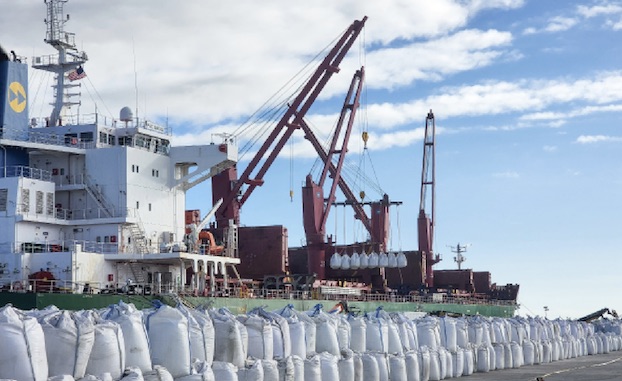Essential economic driver: Port of Lake Charles nation’s 13th busiest port
Published 7:45 am Monday, February 26, 2024

- Bags of dry cement are imported from Turkey and used for soil stabilization projects at area LNG plants. (Special to the American Press)
The Port of Lake Charles had a record year in 2022, and again in 2023.
But 2024 could be even better.
Port Executive Director Richert Self updated the American Press last week on some of the port’s latest news. Earlier that morning, he had just signed a lease with a company that wants to do fabrication on the port’s industrial canal site. The day before, Louisiana Economic Development announced Lake Charles Methanol II would build the first methanol manufacturing plant in the world to capture and sequester its own CO2 – and it would be doing that on port property.
The potential for blue ammonia projects could mean the leasing of significant port acreage, according to Self — who has seen interest from more than one multinational company.
Being 13th has nothing to do with luck
The port manages the Calcasieu Ship Channel, which runs inland 36 miles and extends out into the Gulf of Mexico another 32 miles and is officially named the Lake Charles Harbor and Terminal District. This district encompasses 203 square miles in Calcasieu Parish and operates on 5,420 acres. It owns and operates two marine terminals and two industrial parks.
Despite the port’s size, Self said he can certainly envision a day when it’s completely leased. Only 800 acres remain. Shipments from existing LNG export terminals are on the increase with more projects proposed and in the permitting stage, currently stalled by the Biden administration’s pause.
Leasing its property is just one of the ways the port generates revenues. Cargo tonnage — including that of port partners and in some cases casino headcount percentages — also increases the bottom line.
The list of the nation’s busiest ports is compiled based on import and export tonnage, the more tonnage, the busier the port. The deepwater Port of Lake Charles ranks 13. Only 50 of the nearly 150 ports are ranked.
Here’s another way to gauge the scope of the port’s business. The Calcasieu Ship Channel contributes $38 billion to the Gross Domestic Product of the nation, accounting for two-thirds of the GDP of Calcasieu and Cameron parishes combined based on a recent Lake Charles Harbor and Terminal District Study.
Self said in 2022, the Port of Lake Charles posted 16.7 million tons, making it a record year. Last year was also a record year, and in 2024, the port is projected to record nearly 18 million tons.
From the export of petroleum coke, a byproduct of local industry processes used as feedstocks by other industries; to the export of liquified natural gas; to the import of Barite used in drilling and cement from Turkey used for LNG soil stabilization projects; to becoming a national pathway for wind energy, the Port of Lake Charles is an energy port, and supportive of what Self describes as an “all-of-the- above-approach for energy.”
“I read an article that referred to the ‘energy transition,’ as the ‘energy addition,’ ” he said, and explained the demand for refined petroleum products will continue to increase well into 2050, according to the article, but several clean energy sources such as hydrogen, wind and solar will be in addition to traditional energy sources.
Not just an energy port
The Port of Lake Charles might be an “energy” port, but lumber imports contribute to port tonnage in a major way, Self said.
In 2019, 13,000 cubic board meters made its way from suppliers to Lake Charles. In 2023, the number went to 350,000 cbm — mostly spruce — from Sweden, Germany and Austria from suppliers such as Bindenholz, Mercer, QP Timber, Vida and Brunswick.
Growth and still rebuilding
The port’s new tenants, its ranking and GDP numbers are big news and a great indicator of where Southwest Louisiana is headed as an economy, but the bigger story is the port posted growth despite the pandemic and despite hurricanes that sent ship loaders and other equipment out to sea and damaged structures that have stood against winds and waves for years.
Currently, the Port of Lake Charles is engaged in its single-largest capital project in its almost 100-year history. Repairing damage from the hurricanes will have a price tag of $168 million for new berth space, covered storage and back warehouses. New shiploaders are finally on their way to speed up the port’s busy operations.
Self sees 2024 as another record year, and it’s only two months in.
“We are on a great trajectory,” he said.




